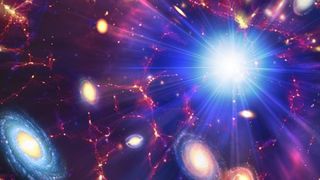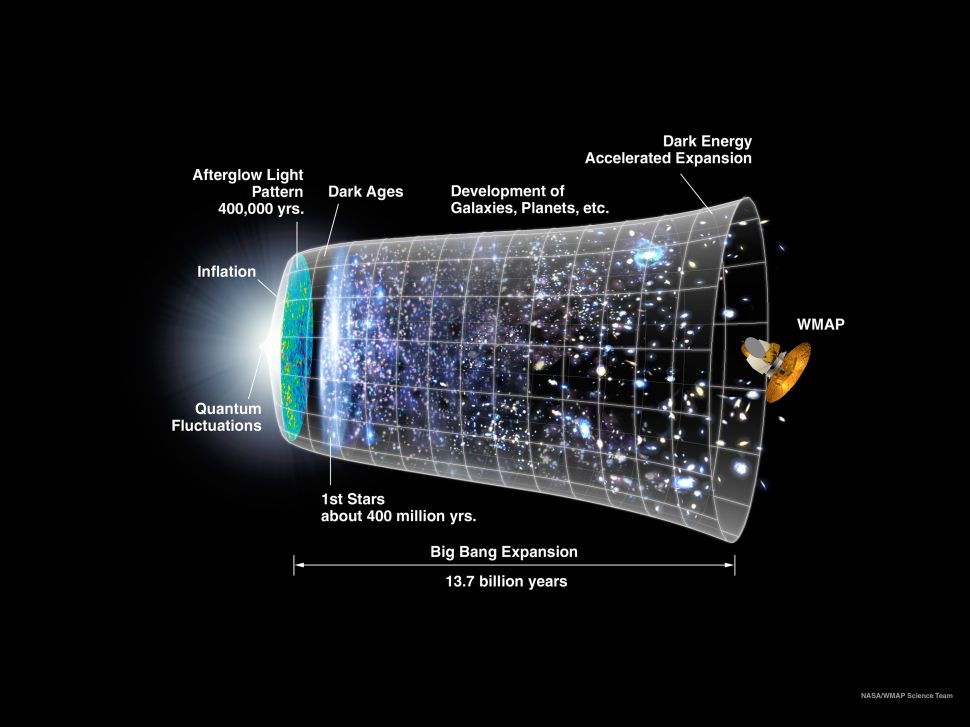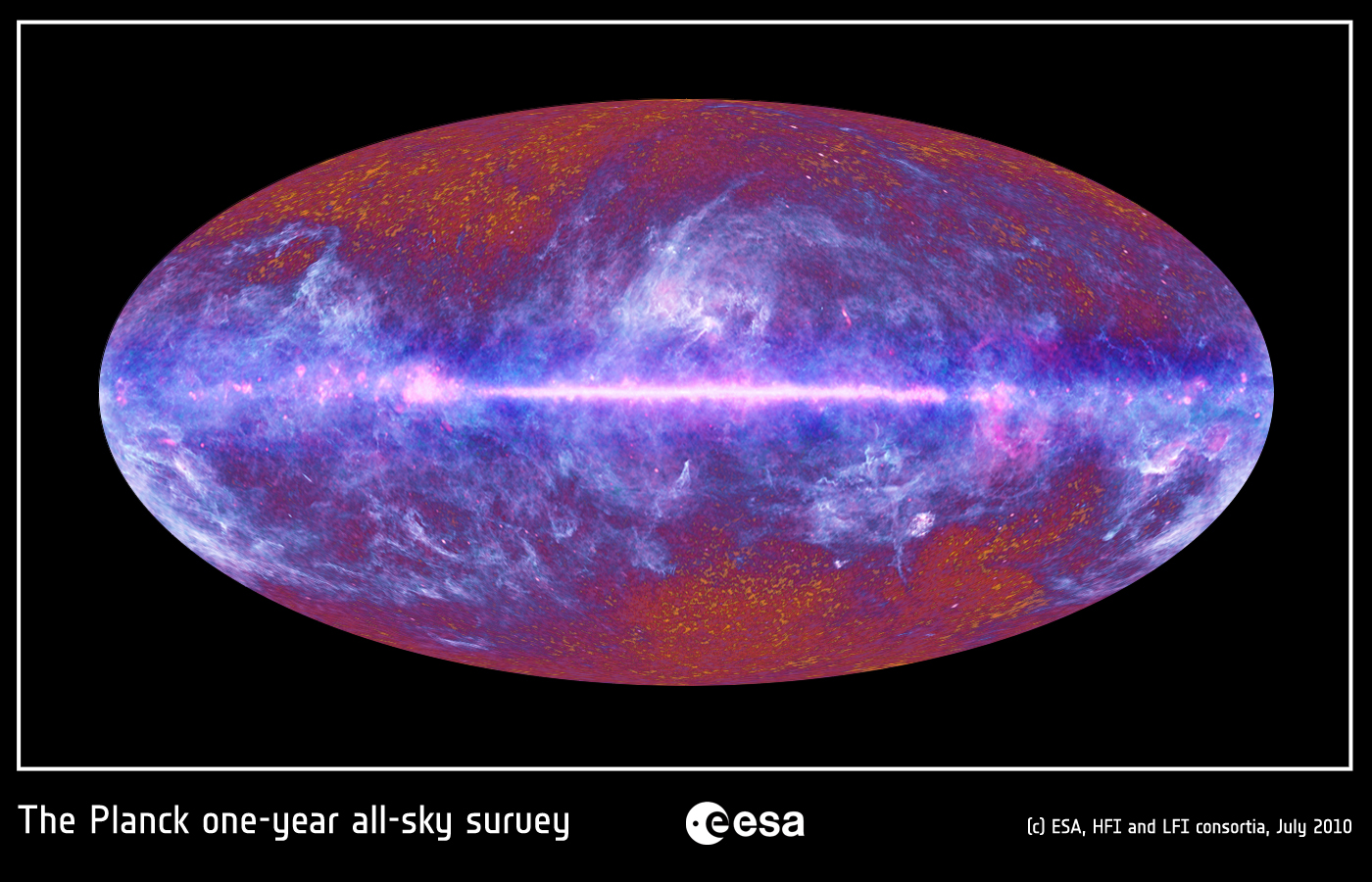Chinas Hole Again History of the Universe
The Large Bang: What really happened at our universe's birth?

It took quite a bit more than than seven days to create the universe as we know information technology today. SPACE.com looks at the mysteries of the heavens in our eight-part series: The history & future of the cosmos . This is Part 5 in that series.
Our universe was born about 13.vii billion years ago in a massive expansion that blew space upwardly like a gigantic balloon.
That, in a nutshell, is the Big Bang theory, which near all cosmologists and theoretical physicists endorse. The bear witness supporting the thought is extensive and disarming. We know, for example, that the universe is still expanding even now, at an ever-accelerating rate.
Scientists have besides discovered a predicted thermal imprint of the Large Blindside, the universe-pervading cosmic microwave background radiation. And we don't see whatever objects obviously older than 13.7 billion years, suggesting that our universe came into beingness around that time.
"All of these things put the Large Blindside on an extremely solid foundation," said astrophysicist Alex Filippenko of the University of California, Berkeley. "The Big Blindside is an enormously successful theory."
And then what does this theory teach us? What really happened at the nativity of our universe, and how did it take the shape nosotros discover today?
Related: The history of the universe: Big Bang to now in ten easy steps
The beginning
Traditional Large Bang theory posits that our universe began with a singularity — a point of infinite density and temperature whose nature is difficult for our minds to grasp. All the same, this may not accurately reflect reality, researchers say, because the singularity idea is based on Einstein'south theory of general relativity.
"The problem is, there's no reason whatsoever to believe general relativity in that regime," said Sean Carroll, a theoretical physicist at Caltech. "It's going to be wrong, because it doesn't have into account quantum mechanics. And quantum mechanics is certainly going to be important one time you lot go to that place in the history of the universe."
So the very beginning of the universe remains pretty murky. Scientists think they can pick the story upward at near x to the minus 36 seconds — 1 trillionth of a trillionth of a trillionth of a 2d — after the Big Bang.
At that point, they believe, the universe underwent an extremely brief and dramatic period of inflation, expanding faster than the speed of light. It doubled in size perhaps 100 times or more, all within the bridge of a few tiny fractions of a second.
(Inflation may seem to violate the theory of special relativity, but that's non the case, scientists say. Special relativity holds that no data or thing can be carried between two points in space faster than the speed of low-cal. Merely inflation was an expansion of space itself.)
"Inflation was the 'bang' of the Big Bang," Filippenko told Infinite.com "Before inflation, in that location was merely a little bit of stuff, quite perhaps, expanding just a footling bit. We needed something like inflation to make the universe big."
This rapidly expanding universe was pretty much empty of matter, but it harbored huge amounts of dark free energy, the theory goes. Dark energy is the mysterious force that scientists think is driving the universe's electric current accelerating expansion.
During inflation, night energy made the universe smooth out and accelerate. Simply it didn't stick around for long.
"It was just temporary dark energy," Carroll told SPACE.com. "It converted into ordinary matter and radiation through a procedure called reheating. The universe went from being cold during inflation to being hot again when all the dark energy went abroad."
Scientists don't know what might have spurred inflation. That remains one of the primal questions in Big Bang cosmology, Filippenko said.

Big bounciness
Most cosmologists regard inflation as the leading theory for explaining the universe'due south characteristics — specifically, why it's relatively apartment and homogeneous, with roughly the same amount of stuff spread out equally in all directions.
Various lines of evidence betoken toward inflation being a reality, said theoretical physicist Andy Albrecht of the University of California, Davis.
"They all hang together pretty nicely with the inflationary picture," said Albrecht, one of the architects of aggrandizement theory. "Aggrandizement has done incredibly well."
However, inflation is not the only idea out in that location that tries to explain the universe's structure. Theorists have come up up with another 1, called the cyclic model, which is based on an before concept called the ekpyrotic universe.
This idea holds that our universe didn't sally from a single point, or anything like it. Rather, it bounced into expansion — at a much more sedate pace than the aggrandizement theory predicts — from a pre-existing universe that had been contracting. If this theory is correct, our universe has likely undergone an endless succession of bangs and crunches.
"The beginning of our universe would take been nice and finite," said Burt Ovrut of the Academy of Pennsylvania, ane of the originators of ekpyrotic theory.
The cyclic model posits that our universe consists of xi dimensions, only four of which we tin can notice (three of infinite and i of fourth dimension). Our four-dimensional function of the universe is chosen a brane (brusk for membrane).
There could be other branes lurking out in that location in eleven-dimensional infinite, the thought goes. A collision between 2 branes could have jolted the universe from wrinkle to expansion, spurring the Large Bang we see evidence of today.

The universe we know takes shape
But first, how did our universe spring up out of nothing? Cosmologists suspect that the iv forces that rule the universe — gravity, electromagnetism and the weak and strong nuclear forces — were unified into a single force at the universe's birth, squashed together considering of the extreme temperatures and densities involved.
Only things changed equally the universe expanded and cooled. Around the fourth dimension of inflation, the stiff force likely separated out. And past well-nigh 10 trillionths of a second subsequently the Big Bang, the electromagnetic and weak forces became distinct, also.
Just after inflation, the universe was likely filled with a hot, dumbo plasma. Only past effectually one microsecond (10 to the minus 6 seconds) or so, information technology had cooled enough to allow the first protons and neutrons to form, researchers think.
In the first iii minutes after the Large Blindside, these protons and neutrons began fusing together, forming deuterium (too known equally heavy hydrogen). Deuterium atoms then joined upwards with each other, forming helium-four.
Recombination: The universe becomes transparent
These newly created atoms were all positively charged, as the universe was notwithstanding as well hot to favor the capture of electrons.
But that changed about 380,000 years later the Large Bang. In an epoch known equally recombination, hydrogen and helium ions began snagging electrons, forming electrically neutral atoms. Lite scatters significantly off free electrons and protons, merely much less so off neutral atoms. And so photons were now much more than gratuitous to cruise through the universe.
Recombination dramatically changed the expect of the universe; it had been an opaque fog, and now it became transparent. The cosmic microwave groundwork radiation nosotros observe today dates from this era.
But nonetheless, the universe was pretty nighttime for a long time afterward recombination, only truly lighting up when the commencement stars began shining about 300 million years after the Big Blindside. They helped undo much of what recombination had accomplished. These early stars — and perhaps some other mystery sources — threw off enough radiation to separate most of the universe's hydrogen dorsum into its constituent protons and electrons.
This process, known as reionization, seems to have run its grade past around i billion years after the Big Bang. The universe is not opaque today, as information technology was before recombination, because it has expanded and then much. The universe's matter is very dilute, and photon handful interactions are thus relatively rare, scientists say.
Over time, stars gravitated together to form galaxies, leading to more and more large-scale construction in the universe. Planets coalesced around some newly forming stars, including our own sun. And 3.viii billion years ago, life took root on Earth.
Before the Big Blindside?
While much most the universe's first few moments remains speculative, the question of what preceded the Big Bang is fifty-fifty more mysterious and difficult to tackle.
For starters, the question itself may be nonsensical. If the universe came from nothing, as some theorists believe, the Big Bang marks the instant when time itself began. In that instance, in that location would be no such matter as "before," Carroll said.
Just some conceptions of the universe's birth tin can propose possible answers. The circadian model, for example, suggests that a contracting universe preceded our expanding ane. Carroll, every bit well, can imagine something existing earlier the Large Bang.
"Information technology could just be empty space that existed before our Big Bang happened, and then some quantum fluctuation gave nascency to a universe similar ours," he said. "You can imagine a little chimera of space pinching off through a fluctuation and being filled with just a little tiny dollop of energy, which can then grow into the universe that we encounter through inflation."
Filippenko likewise suspects something along those lines might exist truthful.
"I retrieve time in our universe started with the Big Blindside, only I think we were a fluctuation from a predecessor, a mother universe," Filippenko said.
Will we ever know?
The European Space Agency'due south Planck mission, which orbited Earth from 2009 to 2013, helped cosmologists fine-tune their ideas about the nature of our universe and its origins. The detailed map of the cosmic microwave background the spacecraft generated revealed that our universe, fifty-fifty if it may have sprung upward from a predecessor, is not probable to contract again in the future, astrophysicist Dave Clements of Imperial College London, told Space.com.
"Planck tin't exclude the bouncing universe concept altogether, but given the current values of the cosmological parameters, our universe is not going to recollapse," Clements said. "The dark energy component, which is accelerating the expansion of the universe at the moment, would have to change to contrary that expansion and drive a big crunch."
Using Planck'southward data, scientists were able to fine-melody their estimates of the universe'southward age as well as of the corporeality of visible matter, dark matter and dark energy in it. The mission, Clements said, didn't evangelize any surprises and mostly confirmed existing theories.
"It shows that this is the maximally boring universe," Clements said.
Yet, a few new questions emerged from its results. For example, the Hubble constant, which describes the rate of the universe's expansion, appears marginally different as measured past Planck in the distant universe, compared to its value given by the Hubble Space Telescope based on measurements in the well-nigh universe, said Clements.
All these $.25 of data help cosmologists better model the universe'due south development and get closer to answering the big questions about the origins of everything. The upcoming European Space Bureau mission chosen Euclid, which is scheduled for launch in 2023, is expected to make further steps in that management.
What'southward next
The Euclid mission will await at how clusters and galaxies are scattered in the universe on the large calibration to assistance astronomers amend understand the effects of dark energy. Information technology volition also study what astronomers telephone call weak gravitational lensing, the angle of light caused by the gravitational pull of very massive objects. Since over 80% of matter in the universe is invisible, the strength of the lensing could give astronomers hints about the distribution of dark matter.
"What Euclid will be able to practice is measure this over much, much larger scales over maybe nearly half the the extragalactic sky or more," said Clements.
Farther pieces of this catholic jigsaw puzzle may come from the study of gravitational waves, the ripples in infinite time generated in collisions of supermassive objects such equally black holes and neutron stars.
Gravitational waves, Clements said, must accept been produced during aggrandizement, the period of rapid expansion in the first moments of the universe's existence. Detecting those early gravitational waves and decoding their backdrop may therefore provide unprecedented insights into the universe's birth.
"This will tell usa something well-nigh the physics that drove the early on, very rapid expansion of the universe," said Clements. "We're really getting back to the very, earliest moments and if we sympathise inflation better, we will hopefully be able to empathize amend whether the Large Bang was a atypical issue or whether this bouncing thought might be right."
You can follow SPACE.com senior writer Mike Wall on Twitter: @michaeldwall. Follow Infinite.com for the latest in space science and exploration news on Twitter @Spacedotcom and on Facebook.
Boosted resources
To acquire more almost the Planck mission and its quest to sympathize the origins of the universe visit this European Space Agency'due south website. For information nigh the upcoming EUCLID mission go hither.
For more data nigh the study of primordial gravitational waves and how they can help unlock the mysteries of the universe's nascency, read this MIT article.
Bibliography
Muia, F., Big bang: how nosotros are trying to 'listen' to it – and the new physics it could unveil, The Conversation, July fifteen, 2021
https://theconversation.com/big-bang-how-we-are-trying-to-listen-to-it-and-the-new-physics-it-could-unveil-164502
Castelvecchi, D., How gravitational waves could solve some of the Universe'south deepest mysteries, Nature, April 11, 2018
https://www.nature.com/manufactures/d41586-018-04157-6
ESA, Planck
https://sci.esa.int/spider web/planck
ESA, Euclid
https://sci.esa.int/spider web/euclid
This reference commodity, originally posted on Oct. 21,2011, was updated on Feb. 4, 2022.
Join our Space Forums to keep talking infinite on the latest missions, night heaven and more! And if you have a news tip, correction or comment, permit usa know at: community@space.com.
varnermannery1952.blogspot.com
Source: https://www.space.com/13347-big-bang-origins-universe-birth.html

0 Response to "Chinas Hole Again History of the Universe"
Postar um comentário